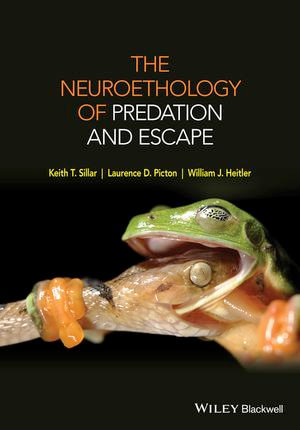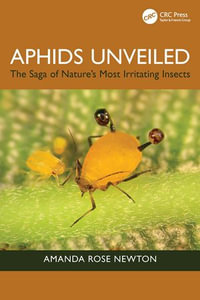
eTEXT
The Neuroethology of Predation and Escape
By: Keith T. Sillar, Laurence D. Picton, William J. Heitler
eText | 23 February 2016 | Edition Number 1
At a Glance
ePUB
eText
$92.39
or 4 interest-free payments of $23.10 with
orInstant online reading in your Booktopia eTextbook Library *
Read online on
Not downloadable to your eReader or an app
Why choose an eTextbook?
Instant Access *
Purchase and read your book immediately
Read Aloud
Listen and follow along as Bookshelf reads to you
Study Tools
Built-in study tools like highlights and more
* eTextbooks are not downloadable to your eReader or an app and can be accessed via web browsers only. You must be connected to the internet and have no technical issues with your device or browser that could prevent the eTextbook from operating.
THE NEUROETHOLOGY OF PREDATION AND ESCAPE
To eat and not get eaten is key to animal survival, and the arms race between predators and prey has driven the evolution of many rapid and spectacular behaviours.
This book explores the neural mechanisms controlling predation and escape, where specialisations in afferent pathways, central circuits, motor control and biomechanics can be traced through to natural animal behaviour.
Each chapter provides an integrated and comparative review of case studies in neuroethology. Ranging from the classic studies on bat biosonar and insect counter-measures, through to fish-eating snails armed with powerful neurotoxins, the book covers a diverse and fascinating range of adaptations. Common principles of biological design and organization are highlighted throughout the text.
The book is aimed at several audiences:
- for lecturers and students. This synthesis will help to underpin the curriculum in neuroscience and behavioural biology, especially for courses focusing on neuroethology
- for postgraduate students. The sections devoted to your area of specialism will give a flying start to your research reading, while the other chapters offer breadth and insights from comparative studies
- for academic researchers. The book will provide a valuable resource and an enjoyable read
Above all, we hope this book will inspire the next generation of neuroethologists.
Read online on
What this book is about, xiii
How this book is organised, xv
Who this book is for, xvi
Acknowledgements, xvi
References, xvii
1 Vision, 2
1.1 The electromagnetic spectrum, 3
1.2 Eyes: acuity and sensitivity, 5
1.2.1 Foveae, 6
1.3 Feature recognition and releasing behaviour, 8
1.4 Prey capture in toads, 9
1.4.1 Attack or avoid: 'worms' and 'anti?-worms', 9
1.4.2 Retinal processing, 11
1.4.3 Feature detector neurons, 12
1.4.4 Modulation and plasticity, 14
1.4.5 Toad prey capture: the insects fight back, 15
1.5 Beyond the visible spectrum, 16
1.5.1 Pit organs, 16
1.5.2 Thermotransduction, 20
1.5.3 Brain processing and cross?-modal integration, 21
1.5.4 Behaviour, 22
1.5.5 Infrared defence signals, 25
1.6 Aerial predators: dragonfly vision, 27
1.6.1 Dragonfly eyes, 27
1.6.2 Aerial pursuit, 28
1.6.3 Predictive foveation, 29
1.6.4 Reactive steering: STMDs and TSDNs, 30
1.7 Summary, 31
Abbreviations, 32
References, 32
2 Olfaction, 36
2.1 Mechanisms of olfaction, 38
2.1.1 Detection and specificity, 38
2.1.2 Olfactory sub?-systems, 40
2.1.3 Brain processing, 41
2.2 Olfactory tracking and localisation, 41
2.3 Pheromones and kairomones, 45
2.3.1 Alarm pheromones, 45
2.3.2 Predator odours, 46
2.3.3 Dual purpose signals: the MUP family, 47
2.3.4 Parasites: when kairomones go bad!, 49
2.4 Summary, 50
Abbreviations, 51
References, 51
3 Owl Hearing, 54
3.1 Timing and intensity, 56
3.2 Owl sound localisation mechanisms, 58
3.3 Anatomy, 60
3.4 Neural computation, 61
3.4.1 The auditory map, 62
3.4.2 Early stage processing, 66
3.4.3 ITD processing, 69
3.4.4 IID processing, 76
3.5 Combining ITD and IID specificity in the inferior colliculus, 77
3.6 Audio?-visual integration and experience?-dependent tuning of the auditory map, 78
3.6.1 Audio?-visual discrepancy can re?-map the ICC?-ICX connections, 80
3.6.2 Motor adaptation, 82
3.6.3 Age and experience matter!, 82
3.6.4 Cellular mechanisms of re?-mapping, 82
3.7 Summary, 83
Abbreviations, 84
References, 85
4 Mammalian Hearing, 88
4.1 Spectral cues, 90
4.1.1 Neural processing of spectral cues, 90
4.2 Binaural processing, 92
4.2.1 IID processing, 93
4.2.2 ITD processing, 94
4.2.3 Calyx of Held, 99
4.3 Do mammals have a space map like owls? 100
4.4 Comparative studies in mammals, 101
4.5 Summary, 102
4.5.1 Caveats, 102
Abbreviations, 102
References, 103
5 The Biosonar System of Bats, 106
5.1 Bat echolocation, 107
5.1.1 Why ultrasound? 108
5.1.2 Range limits, 109
5.2 The sound production system, 109
5.2.1 Types of sound: CF and FM pulses, 110
5.2.2 Echolocation in predation: a three?-phase attack strategy, 112
5.2.3 Duty cycle and pulse?-echo overlap, 113
5.3 The sound reception system, 114
5.3.1 Bats have big ears, 114
5.3.2 Peripheral specialisations: automatic gain control and acoustic fovea, 115
5.4 Eco?-physiology: different calls for different situations, 116
5.4.1 Target discovery, 117
5.4.2 Target range and texture, 118
5.4.3 Target location, 119
5.4.4 Target velocity: the Doppler shift, 119
5.4.5 Target identity: flutter detection, 121
5.4.6 Jamming avoidance response, 123
5.4.7 Food competition and intentional jamming, 123
5.5 Brain mechanisms of echo detection, 124
5.5.1 The auditory cortex, 125
5.5.2 Range and size analysis: the FM?-FM area, 125
5.5.3 Velocity analysis: the CF?-CF area, 128
5.5.4 Fine frequency analysis: the DSCF area, 130
5.6 Evolutionary considerations, 131
5.7 The insects fight back, 132
5.7.1 Moth ears and evasive action, 132
5.7.2 Bad taste, 133
5.7.3 Shouting back, 134
5.8 Final thoughts, 135
5.9 Summary, 136
Abbreviations, 137
References, 137
6 Electrolocation and Electric Organs, 140
6.1 Passive electrolocation, 142
6.1.1 Ampullary electroreceptors, 142
6.1.2 Prey localisation, 145
6.1.3 Mammalian electrolocation, 146
6.2 Electric fish, 148
6.3 Strongly electric fish, 151
6.3.1 Freshwater fish: the electric eel, 151
6.3.2 Marine fish: The electric ray, 156
6.3.3 Avoiding self?-electrocution, 158
6.4 Active electrolocation, 158
6.4.1 Weakly electric fish, 158
6.4.2 Tuberous electroreceptors, 161
6.4.3 Brain maps for active electrolocation, 163
6.4.4 Avoiding detection, mostly, 164
6.4.5 Frequency niches, 166
6.4.6 The jamming avoidance response, 167
6.5 Summary, 174
Abbreviations, 175
References, 175
7 The Crayfish Escape Tail?-Flip, 178
7.1 Invertebrate vs. vertebrate nervous systems, 179
7.2 Tail?-flip form and function, 180
7.3 Command neurons, 182
7.4 Motor output, 184
7.4.1 Directional control, 184
7.4.2 Rectifying electrical synapses, 186
7.4.3 Depolarising inhibition, 188
7.4.4 FF drive and the segmental giant neuron, 189
7.4.5 Limb activity during GF tail?-flips, 189
7.4.6 Tail extension, 190
7.4.7 Non?-giant tail?-flips, 190
7.5 Activation of GF tail?-flips, 191
7.5.1 Coincidence detection, 193
7.5.2 Habituation and prevention of self?-stimulation, 195
7.6 Modulation and neuroeconomics, 196
7.6.1 Mechanisms of modulation, 197
7.6.2 Serotonin modulation, 198
7.7 Social status, serotonin and the crayfish tail?-flip, 198
7.7.1 Social status effects on tail?-flip threshold, 199
7.7.2 Serotonin effects on tail?-flip threshold depend on social status, 200
7.8 Evolution and adaptations of the tail?-flip circuitry, 202
7.8.1 Penaeus: a unique myelination mechanism gives ultra?-rapid conduction, 205
7.9 Summary, 208
Abbreviations, 208
References, 209
8 Fish Escape: the Mauthner System, 212
8.1 Fish ears and the lateral line, 214
8.1.1 Directional sensitivity, 215
8.2 Mauthner cells, 215
8.2.1 Biophysical properties, 217
8.3 Sensory inputs to M?-cells, 218
8.3.1 Feedforward inhibition and threshold setting, 220
8.3.2 PHP neurons: electrical inhibition, 220
8.4 Directional selectivity and the lateral line, 222
8.4.1 Obstacle avoidance, 223
8.5 M?-cell output, 223
8.5.1 Feedback electrical inhibition: collateral PHP neurons, 223
8.5.2 Spinal motor output, 224
8.5.3 Spinal inhibitory interneurons: CoLos, 224
8.6 The Mauthner system: command, control and flexibility, 226
8.7 Stage 2 and beyond, 230
8.8 Social status and escape threshold, 230
8.9 Adaptations and modifications of the M?-circuit, 233
8.10 Predators fight back: the amazing tentacled snake, 235
8.11 Summary, 239
Abbreviations, 239
References, 240
9 The Mammalian Startle Response, 244
9.1 Pathologies, 246
9.2 Neural circuitry of the mammalian startle response, 248
9.3 Modulation of startle, 250
9.4 Summary, 250
Abbreviations, 251
References, 251
10 The Ballistic Attack of Archer Fish, 254
10.1 The water pistol, 255
10.2 Perceptual problems and solutions, 257
10.3 Learning to shoot, 260
10.4 Prey retrieval by archer fish, 261
10.4.1 Computing the landing point, 262
10.4.2 Orientation, 263
10.4.3 Dash to the target, 264
10.5 Summary, 264
References, 265
11 Catapults for Attack and Escape, 266
11.1 The bow and arrow, 268
11.2 Catapults require multi?-stage motor programmes, 269
11.3 Grasshopper jumping, 270
11.3.1 Biomechanics, 270
11.3.2 The behaviour, 270
11.3.3 The hind legs, 271
11.3.4 The motor programme, 273
11.3.5 Directional control, 279
11.3.6 Evolution of the grasshopper strategy, 279
11.4 Froghoppers: the champion insect jumpers, 280
11.4.1 Ratchet locks, 282
11.4.2 Synchronisation, 282
11.5 Mantis shrimps, 284
11.5.1 Mantis shrimp catapults, 285
11.5.2 Cavitation bubbles, 287
11.6 Snapping (pistol) shrimps, 288
11.7 Multi?-function mouthparts: the trap?-jaw ant, 291
11.8 Prey capture with prehensile tongues, 293
11.8.1 The chameleon tongue: sliding springs and supercontracting muscles, 293
11.8.2 Salamander tongue projection, 297
11.9 Temperature independence of catapults, 300
11.10 Summary, 300
Abbreviations, 301
References, 301
12 Molluscan Defence and Escape Systems, 304
12.1 Squid jet propulsion, 306
12.1.1 Biomechanics, 306
12.1.2 Neural circuitry, 307
12.1.3 Jetting behaviour, 311
12.2 Inking, 312
12.2.1 Neuroecology of inking, 314
12.2.2 Neural circuitry of inking, 315
12.3 Cephalopod colour and shape control, 316
12.3.1 Chromatophores, 317
12.3.2 Iridophores, 319
12.3.3 Leucophores, 321
12.3.4 Photophores, 321
12.3.5 Body shape and dermal papillae, 322
12.4 Summary, 323
Abbreviations, 323
References, 323
13 Neurotoxins for Attack and Defence, 326
13.1 Cone snails, 328
13.1.1 The biology of cone snail envenomation, 329
13.1.2 Conopeptides, 333
13.1.3 The billion dollar mollusc, 340
13.1.4 'Rapid' conch escape, 341
13.2 The neuroethology of 'zombie' cockroaches, 343
13.2.1 Sensory mechanisms of stinger precision, 344
13.2.2 Transient paralysis, 345
13.2.3 Intense grooming, 346
13.2.4 Docile hypokinesia, 346
13.3 Venom resistance, 347
13.3.1 Targeting pain pathways, 350
13.3.2 From pain to analgesia, 350
13.4 Summary, 352
Abbreviations, 352
References, 352
14 Concluding Thoughts, 356
14.1 The need for speed, 358
14.2 Safety in numbers, 360
14.3 The unbalancing influences of humankind, 361
References, 363
Index, 364
ISBN: 9781118527238
ISBN-10: 1118527232
Published: 23rd February 2016
Format: ePUB
Language: English
Audience: Professional and Scholarly
Publisher: Wiley Global Research (STMS)
Country of Publication: GB
Edition Number: 1
























